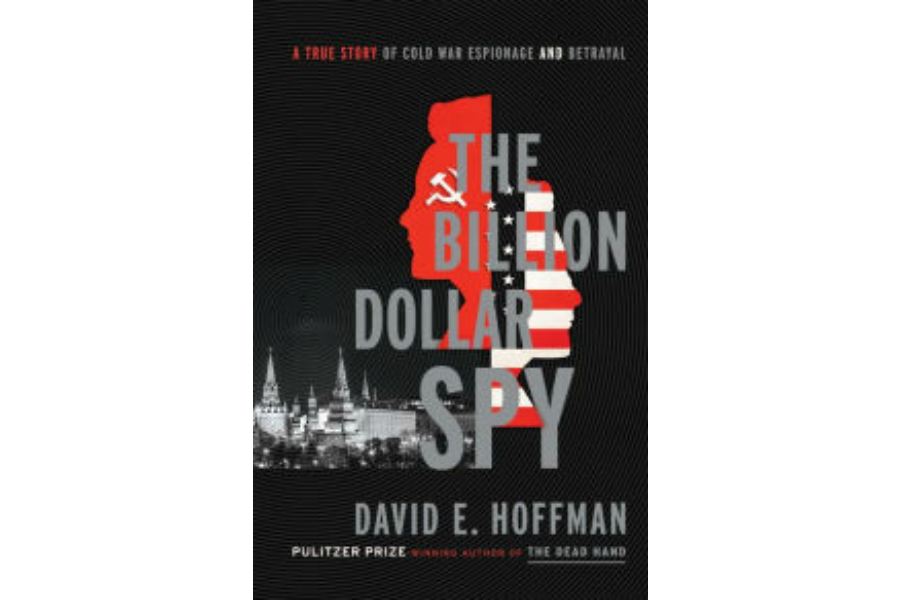'The Billion Dollar Spy': the CIA's secret point man in cold-war-era Moscow
Loading...
Thankfully the subtitle of The Billion Dollar Spy describes this riveting drama as "A True Story of Cold War Espionage and Betrayal." Readers otherwise might assume they have opened a work of fiction, a la John le Carré.
The opening scene features a car wending through the dark streets of Moscow trailed by KGB agents. Inside are a fake birthday cake and two American “diplomats” and their wives – plus a “Jack-in-the-Box” figure stuffed accordion-like inside the cake box. One of the men is wearing two sets of clothing, strips one off, and and dons a disguise face mask as he disappears into the night just as the car turns a corner and is out of view of Soviet surveillance for a few seconds. Up pops “Jack” to take his place in the front seat. The man is off to meet with one of the most productive spies in American history.
Yes, it’s all there: cyanide pills, wonderful spy toys, suspenseful plot twists, ingenious tradecraft, as well as egregious blunders by both the CIA and the KGB. The lead character even sports an evocative surname: Tolkachev.
But this thriller is nonfiction and also packs valuable insights into the final decade of the cloak-and-dagger rivalry between the United States and the former Soviet Union, which came undone in 1989. It is a must-read for historians and buffs of that era, as well as aficionados of espionage.
In his third book Pulitzer Prize-winning author David E. Hoffman draws on extensive declassified CIA and FBI files and myriad other sources to chronicle how the United States gained and lost one of the elite spies of the cold war.
From 1979 to 1985 Adolph Tolkachev was paid more than the president of the United States and was worth every penny. The CIA estimated that he saved the Pentagon roughly $2 billon on R&D costs to counter Soviet ground and airborne radar systems. Thanks in no small part to Tolkachev, American military aircraft would rule the skies in the 1990s against the latest Soviet warplanes flown by Iraqis in the first Gulf War and by Serbs and Croats in the Balkans.
But the United States nearly lost him before they had him. It was Tolkachev’s persistence that finally won the day. On his fifth approach to American officials, he finally was taken seriously. It would be nearly two years from his first unsolicited contact in 1977 to a face-to-face meeting with a CIA case officer in Moscow, right under the noses of the KGB.
America was slow on the draw due to institutional paranoia, according to Hoffman. It was the legacy of legendary CIA chief James Angleton, who for decades saw Russian spies everywhere and was forced to retire in 1974. A new generation of CIA operatives thought the agency should be more proactive and take more risks. Among them was Burton Gerber, who would rise to become Moscow station chief. He developed rules that helped the CIA differentiate between legitimate assets like Tolkachev and KGB “dangles.”
Gerber and company also painstakingly improved CIA tradecraft to allow the agency to operate more easily in the heart of so-called “denied areas” like Moscow, a city that was awash in security forces. The result was that over six years CIA handlers met with Tolkachev 21 times without rousing suspicion.
Perhaps the most compelling part of the book is the relationship between this spy extraordinaire and his dedicated American case officers, who Hoffman writes had to become his “friend and confessor … serve as the agent’s advisor and protector; provide equipment, training, money, and feedback; become the trusted face of the CIA and the United States to someone who had never set foot in America – all of this with a man he hardly knew.”
The reader does get to know Tolkachev and how the capricious cruelty of Joseph Stalin inspired him to betray his country – indeed, to be too ambitious a spy at times. His handlers often urged him to slow down. He was signing out reams of secret files, many unrelated to his own classified work, and spiriting them home during lunch to photograph them. When office security periodically intensified and a two-hour session at home wasn’t an option, he would photograph documents in a bathroom stall. His wife figured out what he was up to. He promised her that he would stop. But he didn’t.
One of the Kafkaesque aspects of this tale is that Tolkachev kept asking for more money, rubbles he couldn’t spend without endangering his mission and his life. What he did receive that was of higher value was banned books by Soviet dissidents such as Alexander Solzhenitsyn and Western rock music for his son by bands like Uriah Heep.
It couldn’t go on forever, of course. A spy’s career is comparable to that of a running back in professional football. Disaster lurks everywhere. The CIA people on the ground in Moscow did their part. But in the end, for all the arcane cleverness of their spy-craft, it was the mundane shortsightedness of people at the top that would lead to the denouement.
In something of an aside, but a telling one, Hoffman reports that Burton Gerber met with Ronald Reagan’s new director of central intelligence, William Casey, in 1981 to update him on Tolkachev and other things he had learned in Moscow. He told Casey that the Soviet Union was a total economic basket case, essentially a dead state walking. “Casey waved him off,” Hoffman writes, adding: “Reagan campaigned in 1980 on a promise to stand up to the Soviet Union, and he was now turning the promise into action.”







